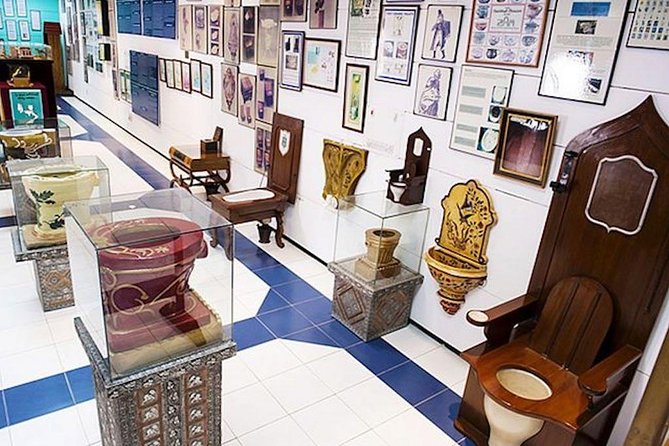Ancient culture and heritage have always been an international draw for travellers and tourists. It is but natural that a country of India's size with an unequalled diversity also possesses many quirky things—one being the Sulabh International Museum of Toilets. In this week, when the art world and museum managers are discussing the post-coved revival of art spaces and cultural hotspots, we spotlight this unique museum, a recipient of many awards.
The Sulabh museum is just one of the two museums devoted to the art and science of potty culture. Located in south-west Delhi, slightly off the touristy circuit of central and historical Delhi, curious tourists find it worth their while to pay a visit to the museum.
A French toilet seat in the form of a book mirrors traditional Anglo-French rivalry at the Sulabh Museum of toilets (Photo: Rahul Kumar)[/caption] It hosts the entire history of toilets and sanitation dating from 2500 BC; depicts humor through cartoons; shows the most technologically evolved toilets; has replicas of toilets that various kings and queens to sit on; as well as the politics behind toilets. Colorful flags of dozens of countries greet you right at the entrance to the museum—all those nations that Sulabh is grateful to for the help by providing information, pictures, literature and letters of support.
Not only has a global effort gone into the museum, but founder Bindeshwar Pathak’s personal endeavor and persistence has made this curious museum a reality. It has taken him about three years to complete the museum. Dr Pathak says: “I got the inspiration from the Madame Tussauds Museum in London. Upon my return I wrote to 100 embassies seeking information about toilets in their cultures and countries. Sixty-one of those embassies provided answers.
Also, I have been on the lookout for sanitary information of different cultures on my travels.” Believe it or not, the idea behind the museum has come from Gandhi’s ideals. The Mahatma’s belief that ‘decent and hygienic disposal of human waste must be central to any society’ inspired Pathak, who has been at the forefront in eradicating the scourge of manual scavenging and providing alternate livelihoods to the Dalit people.
Conceptualised much before cleanliness was taken up in mission mode by the Government of India, this museum is almost an ode to the Swachch Bharat Mission, launched in 2014 by Prime Minister Narendra Modi, which strives to eliminate the practice of manual scavenging. It is not a mean task that the museum has earned itself a rank in the top 10 ‘Weird and Unusual’ museums of the world. The list, compiled by a travel portal, has showered prominence on this extraordinary museum that seeks to confront one of India’s most pestering historical problems. An eye-catching display is the replica of the throne-commode of French king, Louis the XIV.
Called the rumble throne, the simple wooden throne has a commode built under the king’s seat which Louis the XIV would use at his convenience even in the company of people.
The well-known Anglo-French disdain for each other gave rise to another creative toilet—the book toilet. The ingenious French designed a toilet seat in the shape of a book and embossed ‘Macbeth’ along with William Shakespeare’s name on the spine to denigrate the playwright and, also their proud rivals. Evolution during the Victorian era saw a flush of creativity with toilets seats being designed in a variety of colors and patterns including floral.
The curator of the museum, Manoj Kumar Singh, says: “We have showcased toilets and sanitation management systems right from ancient Rome to Crete and, Greece to Babylonia.” Similarly, another interesting exhibit is the two-storied wooden toilet which was in vogue in 1920 in the US. It exclusively demarcated the first-floor toilet for owners and masters while the ground floor toilet was used by their employees. The visualisation is easily understood. Beyond the social, cultural, historical and scientific lies the fun part.
The museum does not allow a visitor to get bored. The displays have cartoons, articles, photographs from around the world and a section on potty humor to lighten up the, often taboo, subject of excreta and sanitation.
For Sulabh, which has done pioneering work in rehabilitating scavengers and cleaning up the country, the biggest sense of achievement comes from the fact that a hitherto forbidden subject has been put into the public domain. As the first prime minister of India, Jawaharlal Nehru, said: “The day every one of us gets a toilet to use, I shall know that our country has reached the pinnacles of success.” And that is what Sulabh International is trying to do with its work on the ground and through the museum.
Closed since March 17, even before the government had declared coronavirus lockdown, the management is eagerly waiting for the government’s guidelines for reopening of public places. <strong>Among other things, the museum also tells us about: The highly evolved sanitary systems of Mohenjodaro and Harappa, shown through wall-mounted photographs. The first water closet system, invented by Sir John Harrington – a courtier in Queen Elizabeth’s entourage, which we still use in some form Toilets which modern-day travellers and adventure-seekers use, with chemical-lined disposal bags that degrade the excreta. The International Space Station toilet technology which the Americans bought from Russia. A replica of electric toilets used by American sailor-soldiers in submarines.




















